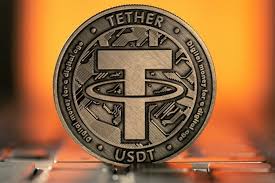In the cryptocurrency market, the USDT wallet is built on three main platforms: Bitcoin, Ethereum, and Tron. Choosing the right platform when using the USDT wallet is an important factor in ensuring safety and efficiency for users.
1. Purpose of USDT
What is USDT and what is the purpose of this cryptocurrency? Simply put, the goal of USDT is to provide a stable form of currency for the cryptocurrency market. USDT is pegged to the US dollar at a 1:1 ratio, meaning 1 USDT always has the same value as 1 US dollar. This helps minimize price volatility compared to other cryptocurrencies on the market.

USDT is also used to trade other types of cryptocurrencies. For example, if you want to buy Bitcoin, you can purchase USDT first and then use USDT to buy Bitcoin. This helps reduce the risk of holding Bitcoin because you can easily sell USDT for cash if the price of Bitcoin drops.
Moreover, USDT is also used for global money transfers and receipts. Using USDT instead of traditional currencies can help reduce transaction costs and transfer times.
2. Operation of USDT
USDT also known as Tether USD, what is it? This is a stablecoin, a type of stable currency whose value is tied to another asset, in this case, the US dollar (USD). Tether USD is issued by Tether Limited, a company headquartered in Hong Kong.
The operation of Tether USD is simple but contains many secrets. When users deposit USD into Tether Limited’s bank account, Tether will create an equivalent amount of USDT for the amount deposited by the user. Conversely, when users want to withdraw USD from Tether, they will send USDT to Tether, and Tether will return the corresponding USD amount.
Tether acts as an intermediary between fiat currency and cryptocurrencies, opening the door for flexible and fast conversion between the two types of currency.

Operation of USDT
- Users deposit USD into the bank account of Tether Limited.
- Tether creates an amount of USDT corresponding to the amount deposited by the user.
- Tether credits the user’s account with USDT.
- Users can use USDT to trade various cryptocurrencies or withdraw USD from Tether.
Currently, Tether USD is the largest capitalized stablecoin in the market, with a value exceeding $70 billion. It is widely used on cryptocurrency exchanges and is considered by many investors as a useful tool to mitigate price volatility risks of other cryptocurrencies.
However, Tether has recently sparked controversy for valid reasons. Some investors are concerned that Tether may not actually have enough USD reserves backing each USDT as they claim. Despite Tether’s rebuttals, there is still no convincing evidence to support their claims.
3. Advantages and limitations of USDT
3.1 Advantages of USDT
- USDT provides stability to users by maintaining a fixed 1:1 value with the US dollar, helping to minimize risks from price fluctuations in the cryptocurrency market.
- USDT has become a popular means of payment in the world of cryptocurrencies, facilitating easy conversion between different currencies.
- The ability to use USDT on various blockchain platforms makes it a flexible tool for cryptocurrency transactions.
3.2 Limitations of USDT
- Despite Tether’s claim that each USDT is backed by 1 USD, transparency regarding their reserves has faced skepticism and controversy.
- Due to the decentralized nature of the cryptocurrency market, there is a risk of USDT being manipulated in price against the USD.
- The uncontrolled use of USDT could open the door to illicit activities such as money laundering or funding illegal operations.
4. Which platforms is the USDT wallet built on?
The USDT wallet, also known as Tether, is developed on three popular blockchain platforms:
- Bitcoin (Omni Layer): The USDT wallet on the Bitcoin platform utilizes the Omni Layer technology, an extension layer of the Bitcoin blockchain. Users can store and trade USDT using wallets that support the Omni Layer technology.
- Ethereum (ERC-20): USDT is also issued as an ERC-20 standard token on the Ethereum blockchain. This enables users to store and exchange USDT on wallets and exchanges that support the ERC-20 standard.
- Tron (TRC-20): Additionally, USDT is built on the Tron blockchain as a TRC-20 standard token. Users can utilize wallets that support the TRC-20 standard to store and trade USDT on the Tron network.

Choosing the appropriate platform when using a USDT wallet is crucial to ensure the safety and efficiency of transactions. When transferring USDT from one platform to another, make sure to use the correct type of wallet and follow specific instructions from the USDT issuer to avoid any unwanted loss.
With its flexibility across leading platforms, the USDT wallet is becoming an essential tool in cryptocurrency transactions. Understanding how to use the USDT wallet on various platforms is imperative to mitigate risks effectively.














